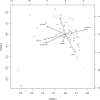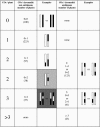Variation in crossing-over rates across chromosome 4 of Arabidopsis thaliana reveals the presence of meiotic recombination "hot spots"
- PMID: 16344568
- PMCID: PMC1356134
- DOI: 10.1101/gr.4319006
Variation in crossing-over rates across chromosome 4 of Arabidopsis thaliana reveals the presence of meiotic recombination "hot spots"
Abstract
Crossover (CO) is a key process for the accurate segregation of homologous chromosomes during the first meiotic division. In most eukaryotes, meiotic recombination is not homogeneous along the chromosomes, suggesting a tight control of the location of recombination events. We genotyped 71 single nucleotide polymorphisms (SNPs) covering the entire chromosome 4 of Arabidopsis thaliana on 702 F2 plants, representing 1404 meioses and allowing the detection of 1171 COs, to study CO localization in a higher plant. The genetic recombination rates varied along the chromosome from 0 cM/Mb near the centromere to 20 cM/Mb on the short arm next to the NOR region, with a chromosome average of 4.6 cM/Mb. Principal component analysis showed that CO rates negatively correlate with the G+C content (P = 3x10(-4)), in contrast to that reported in other eukaryotes. COs also significantly correlate with the density of single repeats and the CpG ratio, but not with genes, pseudogenes, transposable elements, or dispersed repeats. Chromosome 4 has, on average, 1.6 COs per meiosis, and these COs are subjected to interference. A detailed analysis of several regions having high CO rates revealed "hot spots" of meiotic recombination contained in small fragments of a few kilobases. Both the intensity and the density of these hot spots explain the variation of CO rates along the chromosome.
Figures





Similar articles
-
Genome-wide crossover distribution in Arabidopsis thaliana meiosis reveals sex-specific patterns along chromosomes.PLoS Genet. 2011 Nov;7(11):e1002354. doi: 10.1371/journal.pgen.1002354. Epub 2011 Nov 3. PLoS Genet. 2011. PMID: 22072983 Free PMC article.
-
DNA methylation epigenetically silences crossover hot spots and controls chromosomal domains of meiotic recombination in Arabidopsis.Genes Dev. 2015 Oct 15;29(20):2183-202. doi: 10.1101/gad.270876.115. Genes Dev. 2015. PMID: 26494791 Free PMC article.
-
Meiotic recombination hotspots in plants.Biochem Soc Trans. 2006 Aug;34(Pt 4):531-4. doi: 10.1042/BST0340531. Biochem Soc Trans. 2006. PMID: 16856852 Review.
-
Formation of interference-sensitive meiotic cross-overs requires sufficient DNA leading-strand elongation.Proc Natl Acad Sci U S A. 2015 Oct 6;112(40):12534-9. doi: 10.1073/pnas.1507165112. Epub 2015 Sep 21. Proc Natl Acad Sci U S A. 2015. PMID: 26392549 Free PMC article.
-
Playing hide and seek with mammalian meiotic crossover hotspots.Trends Genet. 2007 Jun;23(6):301-9. doi: 10.1016/j.tig.2007.03.014. Epub 2007 Apr 16. Trends Genet. 2007. PMID: 17434233 Review.
Cited by
-
Mapping meiotic single-strand DNA reveals a new landscape of DNA double-strand breaks in Saccharomyces cerevisiae.PLoS Biol. 2007 Dec;5(12):e324. doi: 10.1371/journal.pbio.0050324. PLoS Biol. 2007. PMID: 18076285 Free PMC article.
-
Molecular analysis of a large subtelomeric nucleotide-binding-site-leucine-rich-repeat family in two representative genotypes of the major gene pools of Phaseolus vulgaris.Genetics. 2009 Feb;181(2):405-19. doi: 10.1534/genetics.108.093583. Epub 2008 Dec 15. Genetics. 2009. PMID: 19087965 Free PMC article.
-
Sites of strong Rec12/Spo11 binding in the fission yeast genome are associated with meiotic recombination and with centromeres.Chromosoma. 2008 Oct;117(5):431-44. doi: 10.1007/s00412-008-0159-3. Epub 2008 May 1. Chromosoma. 2008. PMID: 18449558 Free PMC article.
-
An integrated cytogenetic and physical map reveals unevenly distributed recombination spots along the papaya sex chromosomes.Chromosome Res. 2012 Aug;20(6):753-67. doi: 10.1007/s10577-012-9312-1. Epub 2012 Sep 25. Chromosome Res. 2012. PMID: 23007683
-
Genome-wide association mapping in tomato (Solanum lycopersicum) is possible using genome admixture of Solanum lycopersicum var. cerasiforme.G3 (Bethesda). 2012 Aug;2(8):853-64. doi: 10.1534/g3.112.002667. Epub 2012 Aug 1. G3 (Bethesda). 2012. PMID: 22908034 Free PMC article.
References
-
- Anderson, L.K. and Stack, S.M. 2002. Meiotic recombination in plants. Curr. Genomics 3 507-525.
-
- The Arabidopsis Genome Initiative. 2000. Analysis of the genome sequence of the flowering plant Arabidopsis thaliana. Nature 408 796-815. - PubMed
-
- Birdsell, J.A. 2002. Integrating genomics, bioinformatics, and classical genetics to study the effects of recombination on genome evolution. Mol. Biol. Evol. 19 1181-1197. - PubMed
Web site references
-
- http://www.arabidopsis.org/; The Arabidopsis information resource.
-
- http://ftp.tigr.org/pub/data/a_thaliana/ath1/; Arabidopsis sequence database.
-
- http://cran.r-project.org; R software.
Publication types
MeSH terms
LinkOut - more resources
Full Text Sources
Other Literature Sources
Miscellaneous
